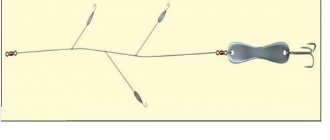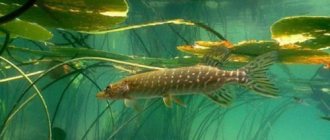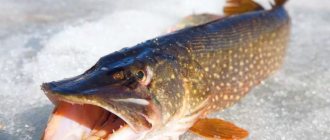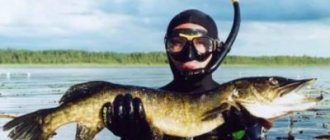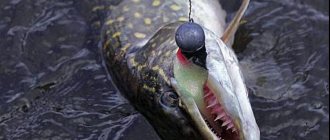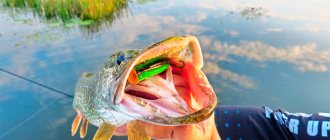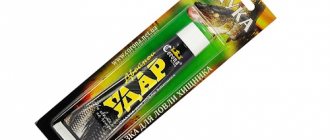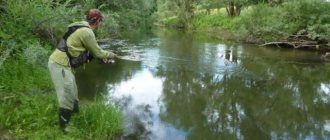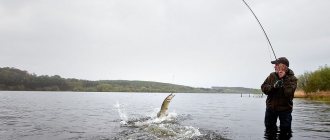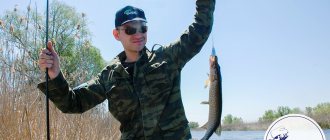The pike is fattening among the thickets of water lilies, and we see this, but we do not risk throwing the bait into the underwater jungle. Why not go fishing in the windows between the continuous carpet of lily pads?
The surface of the water explodes with a sharp splash, raising entire fountains of spray. The roaches run away in panic in all directions. In the center of the commotion, the golden-green body of a predator flashes for a moment. The leaves of the water lilies tremble, like fragile ships during a disaster at sea. A couple of stunned roaches, having come to their senses after the pogrom, quickly disappear. The carpet of water lilies calms down again, as if nothing had happened. Silence and grace all around.
I carefully make my way by boat through the fields of water lilies, deciding to go fishing right in the middle of this green carpet. Risk? Undoubtedly! But, as they say, those who don’t take risks don’t drink champagne. Previously, I, like all my colleagues, fished in the summer only in clean water. But the catches turned out to be small, so I firmly believed in the established prejudice that in the heat the pike hardly feeds.
Cunning grandfathers
The first signs of doubt appeared when I was fishing for carp. It so happened that I constantly saw pikes fattening among the water lilies. Did they really continue to fill their stomachs in the summer? If yes, then why not try to catch pike in continuous thickets of water lilies?
After all, our grandfathers also faced this problem and, by the way, successfully solved it with the help of fishing in the windows, which hardly anyone remembers today. I have been using this method for more than 15 years and I can assure you that for summer pike fishing, especially on small marshy and reed lakes, there is no better method. They fish in windows in the following way: they put a dead fish on a tackle with two tees and a sinker in the mouth. After this, the bait is cast on a long telescopic or three-legged rod, forcing it to play in the clearing between the algae.
This method can also be used to fish from the shore if the body of water is of sufficient depth for the length of the rod.
For example, I kneel down in the boat and stretch my hand with the rod forward, trying to accurately lower the bait fish into the window between the lily pads. For this method, a clearing even the size of a plate is sufficient. You can be sure: here the pike has never seen an angler’s bait before. In addition, this place contains all three components of pike paradise: shade, shelter and food.
Popper and other surface baits
Quite a lot has already been written about poppers, gliders and similar baits. Their use as non-hooking nets is possible only if there is at least a small layer of clean water above the grass. The main advantage of these baits is that they are very “noisy”. That is, the fish will definitely notice them. Whether he will grab it or not is the second question. But there are many chances to lure a pike out of the grass with such bait. Quite often these baits are used precisely as “luring baits”. For example: we see a splash in a thick wall of reeds, in which no bait will pass; the splash occurred 4-5 meters from the edge, while the edge of the cane itself is clean, without grass; It’s difficult to lure a pike with a regular bait from such a distance, so we make several runs with a popper or a propper or a splasher (propper, splasher - the same as a popper but with a propeller), after which we try to catch the pike on a spinner or spoon. How many runs of the Popper should you make before switching to a more familiar bait? I usually do 5-6 postings. Often the pike manifests itself already on the first or second retrieve - it either attacks the bait, or manifests itself by moving the reeds on the edge, or the fry, if there is one, scatters. Is it even worth switching to another bait in this case? Hard to tell. The fact is that the popper has a higher percentage of idle bites than the same spinner or jig with an open hook. Although the popper has open hooks, there are quite a lot of misses when attacking. Apparently, due to the refraction of light at the water-air boundary, the pike simply chooses the wrong angle of attack - yet it cannot be classified as a predator that feeds from the surface. The second option when you need to switch from a popper to a minnow wobbler or a spinner is when the pike is passive. That is, when she comes out to Popper, but doesn’t repeat the attack, or when she doesn’t come out at all. In general, popper does not seduce all pike and not on any day and not in any body of water. I have come across lakes where I could not catch anything at all with a popper, although I visited these lakes quite often and in different seasons. I’ve never had this happen with the same turntables, vibrators and rubber. But as a luring bait, the popper is irreplaceable. Moreover, it is not necessary to lure fish out of the reeds. It could simply be a dense carpet of grass with a clear edge, or the same carpet over which there is a layer of clear water. When the pike is not under the upper edge of the grass, but almost at the bottom, then the popper will be more attractive.
The standard pike size of this bait is from 5 to 10 centimeters. There are also larger models, up to 25 centimeters, but this is either for sea fishing or for real monsters.
I won’t say anything new about wiring poppers and other surface baits. But it’s worth paying attention to non-hook poppers. For example, you can take the Arbogast Weedless Jitterbug bait. This American has a double rigidly mounted in its body, the stings of the hooks of which point upward. Its dimensions of 5 and 6 centimeters are just suitable for a standard pike. This Popper can already be used to fish in places with clearings of grass that reach the surface. We simply drag it along the carpet of grass, and when we hit the window, we start the game. Moreover, this bait belongs to the so-called “eared” poppers, that is, it has 2 blades. In this case, it is one wide metal plate of a special shape. This design allows the bait to play both with a standard jerking retrieve, which we use on a regular popper, and with a regular uniform retrieve. When dragging monotonously, the popper catches the water with its “ears” and plays quite actively, and the hooks directed upwards allow it not to get caught on the grass carpet.
A separate group includes rubber frogs and mice from the American company Snagproof with hooks pressed to the body. These are also surface baits. Their “trick” is that the body of the bait is voluminous and soft, and the stings of the double, which clasps the bait on both sides, are pressed closely to the body. We don’t cling to the grass, and when a pike bites, it easily pushes through the rubber body of the bait and gets hooked. Everything is like non-stick foam rubber. The big plus is that since the thickness of the bait is large, you can use a large hook, which is always good for pike. These baits are mainly made in the form of a popper or glider. I saw Americans and Japanese for sale. The cost of such a bait is closer to a wobbler than to the cost of an elastic band. But the problem is different. Maybe I “fell into” a low-quality product, but out of the 4 models that I had, none of them lasted more than five pikes. The fish simply bites through it, the bait takes on water and no longer moves along the surface (although it flies further with water). I used a lighter and a twister - I melted the twister and dripped it onto the holes. It helped, but not for long.
Let's take a risk, perhaps!
The length of my rod is more than 4 m, which allows me to keep a respectful distance from the window. When fishing from the shore, even longer rods have proven themselves to be excellent - 5-6 m. Only with their help can you reach water lilies in deep water.
With a wrist movement, I force the bait to move from the bottom to the surface of the water: it comes out with a small splash, and then slowly falls down again. First, I fish in the middle of the clearing, then I move to the edges, knowing from experience that this is where the pike lies in ambush. It is located between the algae with its head towards the clearing.
Nothing yet. Well, you need to look. Very carefully I lower the oars and move the boat a few meters forward. At the transition from the water lilies to the reeds there is a narrow, algae-free 10-meter ditch that runs right along the carpet of water lilies. This is where the pike fattened.
Unexpected turn of events
My bait fish goes under the water again. You can’t relax now; the situation requires complete concentration and attention. How often has it happened that the bait, as soon as it was in the water, immediately became the object of attack! And precisely when you sit for several hours in a row without a bite and your attention wanders. An unexpected bite can easily cause a moment of confusion for the angler. We should not forget that the pike must immediately receive an adequate response in the form of a powerful hook. Otherwise, when diving, the fish begins to feel resistance and may throw the bait. If you lower the rod, then when the predator tries to escape, the fishing line will quickly become entangled in the stems of plants. Fishing among water lilies can be tough. You must keep the pike in the clearing using the elasticity of the long rod.
Only use a coil when fighting large specimens. The steel leash should be long (70-80 cm) and without a sheath. Then, when playing, it will work like a scythe for the stems of water lilies. The pike will make its own way; unlike carp, it rarely manages to get caught in the underwater jungle.
Do-it-yourself non-hooking
Non-clinging spinners can be made at home by adapting a classic spinner for this purpose.
Important! To produce the product, you only need a soldering iron and pliers. Additional accessories include a powerful single hook with an extended fore-end and a thick guitar string.
The treble hook and the winding ring for attaching it are removed from the factory spinner. A single hook is soldered into the body of the spinner from its concave part, with the calculation of the projection of the forend with the sting beyond the edge of the body of the product being 1.5 - 2 centimeters. Then cut a piece of string to a size 1/3 larger than the spoon itself with the hook soldered to it. A piece of string is soldered in the front part of the spinner body on the same hook mounting line. After soldering, the string is bent so that it rests on top of the hook tip, creating one center line with it.
The rigidity of the string material allows it to maintain its given shape, and with light pressure it can slightly deform, releasing the sting. This principle helps to avoid snags on the wires with minor resistance, but with more active deformations - and this is mainly the bite of a predator - to release the tip of the hook. With the help of these simple modifications, the spoon significantly changes its purpose and becomes a full-fledged non-hooking spinner for pike.
By the way, if you are a fan of experiments, then
Different biting patterns
The baitfish now dances in the clear water of the ditch. Not a single wave during the dive, not a single bite during the first jump from the bottom. Nevertheless, I continue to fish on the same square meter. There are two types of bites: aggressive, when the bite occurs immediately, and indecisive, when you have to irritate the predator for quite a long time, slightly tugging the bait. Who knows, maybe the recently swallowed prey somewhat calmed down the fattening pike. My roach, its sides shining a little on the surface, again rushes to the bottom. Head first, as if she wants to rummage in the mud. Having poked her muzzle against the bottom a couple of times, she was about to go up, but...
The jerk, short and powerful, makes the rod tip tremble. The water doesn't move. Only to the left, at the edge of the ditch, water lilies swayed. My rod tilts slightly and then shoots up and bends sharply. Eat! Is sitting! A pike tail whips across the surface, and a large cloud of turbidity rises.
With the fury of a lion
With all my might I drag the robber. She desperately resists, trying to hide among the water lilies. I hold back the jerks of the fish with the help of a rod; it spins in place, flaring its gills and shaking its head. Right in front of the boat, for a moment, the pike falls silent on the surface in exhaustion, and I pull the fish in on a stretched line, holding its head above the water. My landing net helpfully takes the pike into its arms. In the boat I measured the trophy: 68 cm, not bad at all!
After this, the water lilies calm down again, as if nothing had happened. And again peace and grace!
Choosing a reservoir for fishing
It is worth remembering that in different bodies of water at the same time, fish are caught with a wide variety of bait. It could be a worm, maggot, bloodworm, semolina, pearl barley, corn and even green peas. Some fishermen say that fish like to bite on lard, but in order to find out how correct this statement is, you should try it at least once. The bite is affected by the time of day, year, location of the reservoir, depth and much more, which experienced fishermen know about.
But be that as it may, do not forget about one basic rule that must be strictly followed. This is to try to be on friendly terms with nature, and for this you don’t need to do any difficult work, you just need not leave garbage behind, don’t kill fish, don’t set up nets, and don’t perform actions that can cause harm. And then the time spent fishing will bring a lot of pleasure, lift your spirits, and delight you with a good catch.
Equipment for fishing in windows
It is best to use a roach about 15 cm long as bait. The tackle consists of a tee No. 1 at the end of the leash, onto which a 5-gram olive sinker is put. Pass a long narrow surgical clamp through the anus into the fish's mouth. Grab the loop of the steel leader with the jaws of the clamp and pull it back through the fish. Now the tee is located directly in the mouth, the sinker is inside the fish. The second tee No. 4 is put on the leash. Wrap it at least five times around the forend of the tee until it fits like a glove.
Stick the hook of the tee above the anus into the base of the fin. The leash between the hooks must be taut so that the tee does not fall out of the mouth, and the fish does not bend when “headstand”. Then the equipment will work well (see picture).
Method of attaching bait fish.
Author: Bert Schroeder
<<<Return to section
